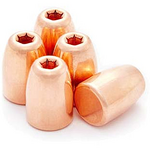Gold Supporter
- Messages
- 25,559
- Reactions
- 38,893
Follow along with the video below to see how to install our site as a web app on your home screen.
Note: This feature may not be available in some browsers.
Reduced case capacity.Wadcutters are essentially a cylinder shaped bullet with no pointy end to enter the rifling? Is there any safety reason why I couldn't load round nose bullets with the base up and the nose in the case?
I could see that being an issue if I pushed the bullet deep into the case like is often done with wadcutters. Maybe using wadcutter load data would compensate for that?Reduced case capacity.
Define your end purpose for doing so.Wadcutters are essentially a cylinder shaped bullet with no pointy end to enter the rifling? Is there any safety reason why I couldn't load round nose bullets with the base up and the nose in the case?
Fun factor and maybe easier field loading.Define your end purpose for doing so.
I would think crimping might also be an issue with the tapered ogive. Bullets might move forward on recoil, altering the OAL and pressure changing for each load.As mentioned, people have loaded rifle bullets backwards. Don't know the results of doing so accuracy wise and barrel life wise.
I am going to give it a shot. I am not expecting accuracy to be great. My concern was how the bullets would engage the throat of the barrel and the rifling.I would think it a bad idea. The round nose would do a crummy job of sealing the bore and not ensuring the projectile entering the bore straight. If you try it, please post your results. I would wager that the accuracy would be horrible as it would be unlikely that any of the bullets would engage the throat of the barrel the same. The only reason that hollow base wadcutters loaded backwards "sort of " worked is because the nose of the, bullet acted as a flat base to properly seal the bore at its base.
Single feeding would be the solution.I would think crimping might also be an issue with the tapered ogive. Bullets might move forward on recoil, altering the OAL and pressure changing for each load.
I will meet in the middle and use plated bullets. Using lead bullets in an unflared case might be problematic. I will try a couple cast bullets to see if lead shaving is a problem.I would try it with cast lead first. I would think pushing a hard jacketed edge against the rifling would wear the barrel down quickly.

